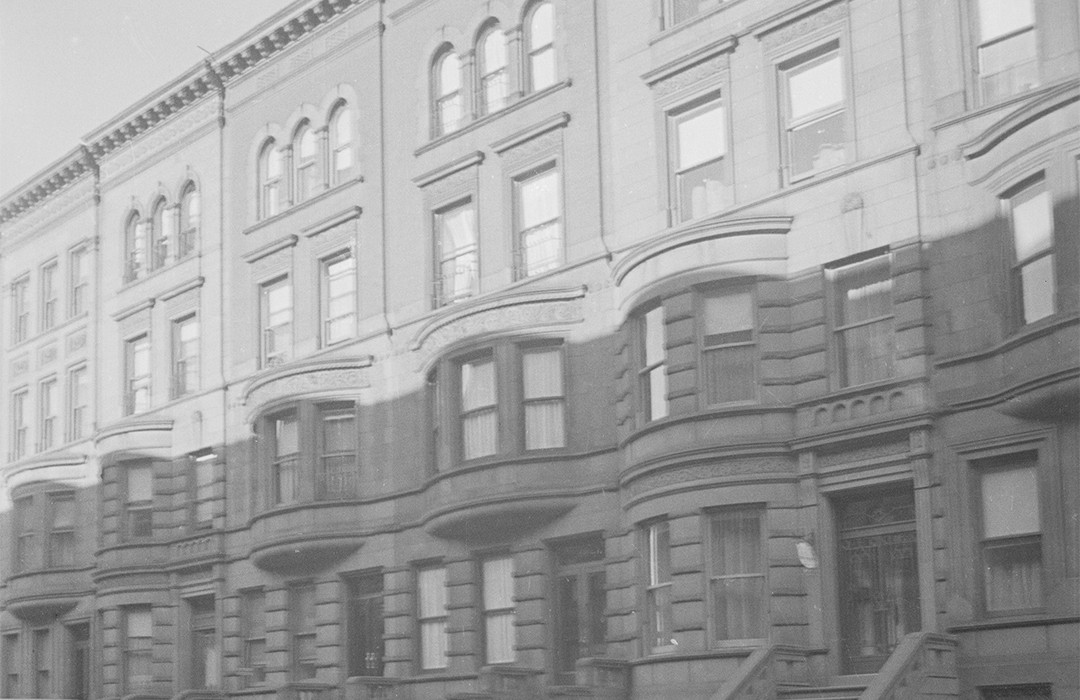
49 West 69th Street
by Tom Miller
In 1892, real estate developer William H. Hall began construction of a row of 10 upscale rowhouses on the north side of West 69th Street between Central Park West and Columbus Avenue. Designed by the architectural firm of Thom & Wilson, the Renaissance Revival style homes were four stories tall above high English basements.
On March 11, 1893, the Record & Guide reported that Hall had sold 49 West 69th Street to “J. Harbison.” The article got the buyer’s name noticeably wrong. He was stockbroker Matthew Harbeson. The Harbesons’ new house was faced in brownstone at the basement and parlor levels, and red brick on the upper floors. Thom & Wilson created a stately presence with a dramatic bowed bay at the second story, Renaissance-inspired carvings around the third-floor windows, and a triple arcade at the fourth.
Harbeson was a lineal descendant of Robert Louis, one of the signers of the Declaration of Independence. He and his wife, the former Julia Wood, had two sons, Matthew L. and George Wood.
…but he would not graduate. Instead, in 1897, he and his father began traveling the world together.
George Wood Harbeson was attending Columbia University when the family moved into 49 West 69th Street, but he would not graduate. Instead, in 1897, he and his father began traveling the world together. Eventually, George would speak seven languages fluently and become a student of classical history.
It is possible that an erosion of domestic bliss prompted Matthew to leave his wife at home. The same year Matthew and George left, the Warren A. Conover family moved in. (It is unclear if Julia Harbeson initially shared the house with them. By 1912, after Matthew’s death, she was living a few houses away at 41 West 69th Street.)
Warren A. Conover was a contractor and builder and a member of several exclusive clubs. His son, John T. Conover, graduated from Columbia University in 1898.
The Conover family stayed through the turn of the century. Then, on March 11, 1903, an advertisement in the New York Herald offered the house for sale. It noted the upscale amenities, including a “conservatory off the dining room” and three baths. The residence was purchased by Giles E. Taintor and his wife in June of that year.
Born in 1839, Taintor was a partner in the brokerage firm of Taintor & Holt. He was also highly involved in railroad building and mining in the West. Living with him and his wife, the former Augusta Hopley Behm, were their bachelor son, Giles Augustus, their daughter Ethel Musier Harper, and Ethel’s husband, John Harper. (The Taintors had three other adult children, Angela L. Phillips, Frederick B. and Harold H.) The family’s summer home was in Woodstock, Vermont.
On January 18, 1904, The Commercial Advertiser reported, “One of the largest receptions of the week will be given by Mrs. Giles E. Taintor in her beautiful new home at 49 West Sixty-ninth street, next Saturday afternoon from 4 until 7 o’clock. Mrs. Taintor will be assisted in receiving by her daughter, Mrs. John Harper.” The article noted, “They will be at home on Mondays in February.” (“At homes” let other socialites know when a lady was receiving.)
Later that year, on June 2, the house was the scene of the wedding of Augusta’s niece, Esther Akin, to Rolland H. French. The Philadelphia College Alumni Report noted, “The stately Taintor mansion had been converted into a veritable bower, roses and greenery being generously used throughout.”
The family’s name appeared in newspapers for a much more solemn reason the following year. Giles Augusts had moved to St. Louis, Missouri. He died there “suddenly,” as reported by The New York Times, on November 18, 1905, at the age of 32.
The Philadelphia College Alumni Report noted, “The stately Taintor mansion had been converted into a veritable bower, roses and greenery being generously used throughout.”
Augusta Hopley Taintor died at the Woodstock house on July 17, 1914. Giles survived her by five years, dying in the West 69th Street house at the age of 80 “after a long illness” on January 12, 1919. In reporting his death, The New York Times mentioned, “He was one of the oldest members of the Union League Club, which he joined fifty-one years ago.”
The Taintor estate held a three-day auction of the “expensive appointments” of 49 West 69th Street beginning on May 15 that year. A year later, on June 5, 1920, the Record & Guide reported that the estate had sold the house to Alfred M. Wolf.
Born in Pennsylvania in 1879, Wolf and his wife Florence had a one-year-old son, Samuel, when they moved in. The family would remain here for many years. In 1940, when Samuel was 21, the Wolfs were taking in two “lodgers,” Saul Friedman and his wife, Rosa.
At some point in the second half of the 20th century, the house was converted to apartments. Simultaneously, the stoop was removed, and the entrance lowered to the former English basement level.
Tom Miller is a social historian and blogger at daytoninmanhattan.blogspot.com


